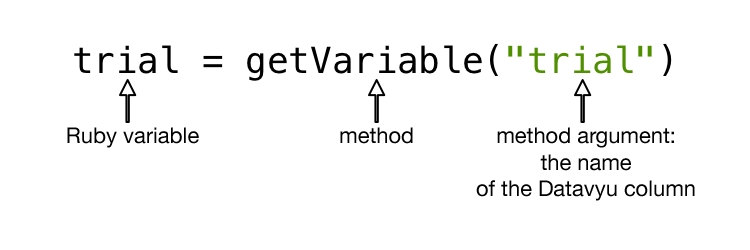API Tutorials¶
Before You Start¶
Sample Data¶
Most of the following tutorials use Example-Template.opf as their basic data file.
The example template contains two columns: “id”, whose codes describe basic information such as subject number, test date, birth date, and condition, and “trial”, which has two codes: trialnum and outcome.
The example has one cell in the “id” column and no cells in the “trial” column. Most of the Datavyu tutorials use the example template as their basis, so if you want to follow along directly, you can download it, and then open it with Datavyu (using File > Open and selecting the file from your hard drive).
Most Datavyu scripts begin by loading a column from Datavyu using the
getColumn() method. Before moving on to the larger tutorial
list, you should familiarize yourself with loading Datavyu columns.
Load Datavyu Columns¶
To load columns, Datavyu provides the
getColumn() method. getColumn() takes one
argument, the name of the column in Datavyu, and returns the Ruby
representation of the column, which you can work with.
The following script retrieves the “trial” column from the Datavyu
spreadsheet and assigns it to an RColumn object called trial.
require 'Datavyu_API.rb'
begin
# Assign the Datavyu column "trial" data to a new Ruby object called trial.
trial = getColumn("trial")
end
The left side of the method is the name of the Ruby object;
the “trial” in the parentheses is the argument passed to
getColumn() (the name of the Datavyu column).

Now that you’re familiar with the sample data and know how to acquire data from Datavyu, you’re ready to start scripting. The following tutorials will guide you through common tasks.
Tutorials¶
Add a New Column¶
Add a column to create a new coding pass or a new set of codes.
Add Codes to a Column¶
Add codes to a column to prompt coders which behaviors to score.
Add Cells to a Column¶
Add cells to a column while coding or annotating a video file.
Check for Coding Errors¶
Check for coding errors such as typos, impossible vlaues, unlikely values, etc.
Use Reliability Coding to Check Data Accuracy¶
Check Inter-rater Reliability to Improve Data Accuracy to determine whether more than one coder would score the data the same way.
Export Data Using Scripts¶
Use scripts to export data from Datavyu into a text file or a spreadsheet. for statistical analyses.
Convert an OpenShapa Script to Datavyu¶
Convert an OpenSHAPA script to the Datavyu format to update an old file.
Perform Operations on Multiple Files¶
Batch operations on multiple files to do the same operation on more than one file.
Convert a MacShapa file to Datavyu¶
Convert MacSHAPA files to work in Datavyu so that you can use the new, supported software.
- Add a New Column
- Add Codes to a Column
- Add Cells to a Column
- Check for Coding Errors
- Check Inter-rater Reliability to Improve Data Accuracy
- Use Scripts to Export Data from Datavyu
- Convert an OpenSHAPA Script to the Datavyu Format
- Batch Operations on Multiple Files
- Convert MacSHAPA Files to Work in Datavyu
